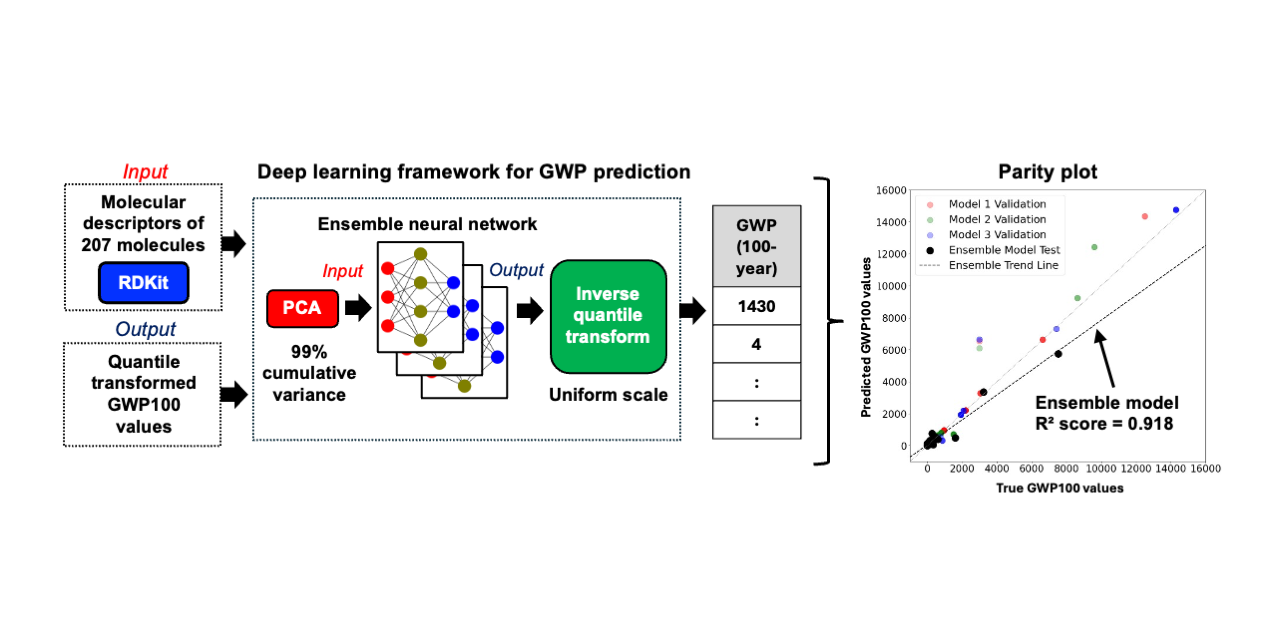Using AI to Predict Global Warming Potential for Sustainable Refrigerant Design

Climate change has become one of the most pressing challenges of our time. Synthetic refrigerants used in cooling systems, such as air conditioning and refrigeration, contribute significantly to greenhouse gas emissions. Many of these refrigerants, like R134a, have global warming potentials (GWPs) that are thousands of times higher than carbon dioxide. This makes them a major target for climate mitigation.
International agreements such as the Kigali Amendment to the Montreal Protocol mandate a global phase-out of high-GWP refrigerants. To meet these targets, we must rapidly identify and deploy alternative refrigerants that are more climate-friendly. However, finding suitable replacements is far from simple. Refrigerants must meet performance standards while also minimizing environmental impact. Navigating these trade-offs can be challenging, especially when chemical complexity and environmental compatibility are both in play.
The Role of AI in Finding Climate-Friendly Refrigerants
Traditional methods for predicting a refrigerant’s GWP rely on group contribution techniques or experimental measurements. These approaches can be time-consuming and often fail to capture complex, nonlinear relationships between molecular structure and environmental impact.
This is where AI can make a real difference. AI models can learn directly from molecular data and find patterns that traditional models may miss. They can quickly screen thousands of potential refrigerant candidates, helping scientists identify promising low-GWP compounds faster and more reliably.
AI Framework for Predicting GWP
In our recent study, we developed a deep learning framework that predicts the 100-year GWP of single-component refrigerants using Multi-Sigma®. The framework combines three essential tools: molecular descriptors, principal component analysis (PCA), and quantile transformation. Here’s how it works:
- Molecular Descriptors: These numerical features encode information about a molecule’s structure and properties. We tested three descriptor sets—RDKit, Mordred, and alvaDesc—each capturing a different level of structural detail. RDKit focuses on basic 2D features, Mordred adds some 3D descriptors, and alvaDesc provides a comprehensive set of 3D descriptors.
- PCA for Dimensionality Reduction: Molecular descriptors can number in the thousands, which can lead to overfitting during AI model training. PCA compresses this information into a smaller set of principal components while retaining the key patterns. This makes the model more stable and easier to interpret.
- Quantile Transformation: GWP data are heavily skewed, with most refrigerants having low GWP and a few having extremely high values. Quantile transformation makes the data more uniform, helping the AI learn effectively from all parts of the dataset.
Performance and Key Findings
We trained ensemble neural networks using these transformed datasets. Each model was evaluated for how well it predicted the GWP of refrigerants it had never seen before. Surprisingly, the simpler RDKit descriptors, which only include 2D features, achieved the best performance with an R-squared (R²) value of0.918 (Figure 1).
This result shows that even with basic structural information, AI can predict GWP with high accuracy. Simpler models often generalize better and are more robust when new data are introduced.

Figure 1. Overview of the deep learning framework for GWP prediction and the prediction results of the RDKit-based ensemble model [1].
Why This Matters: A Broader Perspective
The significance of this work goes beyond predicting a single property. By demonstrating that basic molecular descriptors can produce reliable predictions, we open the door for faster and more scalable virtual screening of refrigerants. This means researchers and companies can:
- Reduce the time and cost of refrigerant discovery
- Identify promising candidates early in the design phase
- Accelerate the phase-out of high-GWP refrigerants to meet climate targets
What Drives GWP? Key Insights from the Model
Beyond the raw predictions, our framework also identifies which molecular features influence GWP the most. This helps chemists understand the link between structure and environmental impact:
- High molecular weight and functional groups like allylic oxides are associated with higher GWP. These features tend to make molecules more stable in the atmosphere, extending their lifetime and their warming effect.
- Aliphatic heterocycles and certain volume-related descriptors can lower GWP by promoting faster degradation. Molecules with these features break down more easily, reducing their impact on climate.
These insights can guide chemists in designing new refrigerants that not only meet performance needs but also contribute less to global warming.
Accessibility and Practical Tools
To make our model widely accessible, we developed a web application that predicts GWP using RDKit molecular descriptors. Anyone can use it to estimate the climate impact of new refrigerants. This tool supports data-driven design and faster testing of new compounds, helping move the field toward more sustainable solutions.
If you are curious to explore how your refrigerant performs, test it with our web tool:
https://multi-sigma-app-v2-dev-jst3cplrqq-an.a.run.app/public_app/i07MbDalAR6xZhJ3lFAb
The Bigger Picture: Aligning with Global Goals
This work supports international efforts to combat climate change. The Kigali Amendment and similar agreements push for a rapid shift to low-GWP refrigerants. Our AI framework can help achieve this by identifying viable alternatives quickly and reliably. It aligns with broader climate targets and contributes to a healthier, more sustainable future.
Beyond Refrigerants: Expanding the Framework
While our current focus is on single-component refrigerants, the same approach can be extended to more complex refrigerant blends. It can also be adapted to predict other environmental properties such as toxicity and atmospheric lifetime. This would allow for a more comprehensive evaluation of refrigerants and other industrial chemicals, supporting broader sustainability goals.
Conclusion
Our study shows that deep learning, when combined with smart data processing, can provide reliable predictions of GWP using simple molecular descriptors. The framework balances accuracy and generalizability, making it a practical tool for early-stage refrigerant design. It bridges the gap between data and environmental responsibility, giving scientists and engineers a powerful tool for sustainability.
Reference
- Rajapriya, Navin, and Kotaro Kawajiri. “Deep Learning for GWP Prediction: A Framework Using PCA, Quantile Transformation, and Ensemble Modeling.” arXiv preprint arXiv:2411.19124 (2024).
機械学習を使った分析や予測が日常的に行われる今、協調フレームとしてのMulti-Sigma®の役割は増すばかりです。
『どのような場面で活用できるのか』をもっと知りたい方や、実際の利用シーンを見てみたい方は、是非一度お気軽にご相談ください。
In a world where machine learning-based analysis and prediction are becoming everyday practices, the role of Multi-Sigma® as a collaborative framework is more crucial than ever.
If you're interested in learning more about how it can be applied or want to see real-world examples, feel free to contact us.





